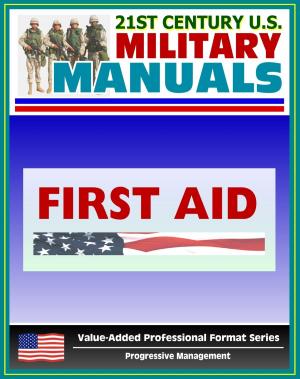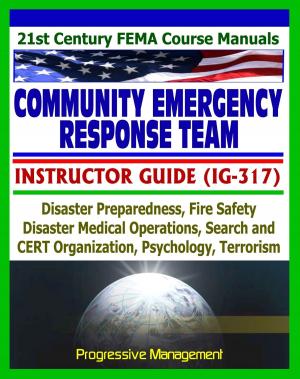History of the Airborne Forward Air Controller (FAC), Mosquito Aircraft, Joint Air Tasking Doctrine, World War I and II, Korea, Vietnam War, Marine Corps, Kosovo, War on Terror, A-10, F-16, F-14, F-18
Nonfiction, History, Military, Vietnam War, Asian, Aviation| Author: | Progressive Management | ISBN: | 9781310896873 |
| Publisher: | Progressive Management | Publication: | July 16, 2016 |
| Imprint: | Smashwords Edition | Language: | English |
| Author: | Progressive Management |
| ISBN: | 9781310896873 |
| Publisher: | Progressive Management |
| Publication: | July 16, 2016 |
| Imprint: | Smashwords Edition |
| Language: | English |
Two excellent reports have been professionally converted for accurate flowing-text e-book format reproduction: The History of the Airborne Forward Air Controller and Rebuilding the Joint Airborne Forward Air Controller: Analyzing Joint Air Tasking Doctrine's Ability to Facilitate Effective Air-Ground Integration.
The US Department of Defense predicts that ground forces of the future will wage tomorrow's wars by replacing large numbers of personnel and organic firepower for advanced technology and superior maneuverability. Those forces must be prepared to face an unconventional enemy who will operate in small, lethal units interspersed with the civilian population rather than facing coalition forces with massed formations. This scenario of blurred lines of battle and difficulty determining friend from foe resembles very closely what the US military faced in Vietnam. This paper will address the successes and failures of United States airborne forward air controllers (FACs), particularly in Vietnam, and whether combat lessons learned were passed from service to service or historically from conflict to conflict. The FAC mission has not significantly changed since the end of the Vietnam War, and a thorough study of operational and tactical lessons learned by those aircrew will significantly enhance today's FACs ability to find and destroy dispersed enemy forces in a wide array of environments.
CHAPTER 1 - AIRBORNE FACs AT WAR * Airborne Observer History * World War I: The Birth of a Concept * The Interwar Years * World War II: Lessons Learned and Forgotten * Korea: Mosquitoes Take Flight * CHAPTER 2 - THE ADVISORY YEARS * US Air Force Counterinsurgency Operations * Farm Gate * O-1 Birddog * CHAPTER 3 - THE SLOW-FAC AIR WAR * FAC Aircraft in Vietnam * USAF FAC Involvement in Vietnam * US Navy FAC Involvement * US Marine Corps FAC Involvement * FAC Operations 1965-1970 * Out-of-Country Operations * Visual Reconnaissance * CHAPTER 4 - THE FAST-FAC AIR WAR * US Marine Corps Fast-FAC: F9F Panther and OA-4 Skyhawk * Operation Commando Sabre: The Misty FAC * Stormy, Wolf, Tiger, and Night Owl: Phantom FACs * Vietnam Lessons Forgotten * CHAPTER 5 - BEYOND VIETNAM: THE DEATH OF LARGE-SCALE AIRBORNE FAC * Marine Corps FACs After Vietnam * New FACs Emerge: Air Force A-10 and F-16 * New FACs Emerge: Navy F-14 and F-18F * Special Operations Forward Air Control * The Next Test: Kosovo 1998 * The Global War On Terror * Where Do We Go From Here? * The Mission of Forward Air Control * The People of Forward Air Control * The Aircraft of Forward Air Control * Conclusion * BIBLIOGRAPHY
Book Two: Lessons learned from Operation Anaconda point to deficiencies in current joint FAC(A) air-ground integration. The primary purpose of this thesis is to determine if current joint air tasking doctrine allows the FAC(A) to effectively integrate into supported ground operations. This study examines potential modifications to joint air tasking doctrine that will allow FAC(A)s to integrate with their supported ground units more effectively. Based on this study, there are two primary methods to successfully integrate the FAC(A) into supported ground operations. The first method is through detailed pre-mission coordination, currently called for in joint doctrine. Consequently, this analysis compares the integration opportunities available in current joint air tasking doctrine to the established requirement for effective FAC(A) integration to determine if current joint air tasking doctrine facilitates effective air-ground integration. Consequently, the analysis also compares current joint air tasking doctrine to the successful models illustrated in the Vietnam War TASS system and the USMC MAGTF to identify potential avenues for improved FAC(A) integration. Finally, the study recommends modifications to joint air tasking doctrine to help improve FAC(A) integration.
Two excellent reports have been professionally converted for accurate flowing-text e-book format reproduction: The History of the Airborne Forward Air Controller and Rebuilding the Joint Airborne Forward Air Controller: Analyzing Joint Air Tasking Doctrine's Ability to Facilitate Effective Air-Ground Integration.
The US Department of Defense predicts that ground forces of the future will wage tomorrow's wars by replacing large numbers of personnel and organic firepower for advanced technology and superior maneuverability. Those forces must be prepared to face an unconventional enemy who will operate in small, lethal units interspersed with the civilian population rather than facing coalition forces with massed formations. This scenario of blurred lines of battle and difficulty determining friend from foe resembles very closely what the US military faced in Vietnam. This paper will address the successes and failures of United States airborne forward air controllers (FACs), particularly in Vietnam, and whether combat lessons learned were passed from service to service or historically from conflict to conflict. The FAC mission has not significantly changed since the end of the Vietnam War, and a thorough study of operational and tactical lessons learned by those aircrew will significantly enhance today's FACs ability to find and destroy dispersed enemy forces in a wide array of environments.
CHAPTER 1 - AIRBORNE FACs AT WAR * Airborne Observer History * World War I: The Birth of a Concept * The Interwar Years * World War II: Lessons Learned and Forgotten * Korea: Mosquitoes Take Flight * CHAPTER 2 - THE ADVISORY YEARS * US Air Force Counterinsurgency Operations * Farm Gate * O-1 Birddog * CHAPTER 3 - THE SLOW-FAC AIR WAR * FAC Aircraft in Vietnam * USAF FAC Involvement in Vietnam * US Navy FAC Involvement * US Marine Corps FAC Involvement * FAC Operations 1965-1970 * Out-of-Country Operations * Visual Reconnaissance * CHAPTER 4 - THE FAST-FAC AIR WAR * US Marine Corps Fast-FAC: F9F Panther and OA-4 Skyhawk * Operation Commando Sabre: The Misty FAC * Stormy, Wolf, Tiger, and Night Owl: Phantom FACs * Vietnam Lessons Forgotten * CHAPTER 5 - BEYOND VIETNAM: THE DEATH OF LARGE-SCALE AIRBORNE FAC * Marine Corps FACs After Vietnam * New FACs Emerge: Air Force A-10 and F-16 * New FACs Emerge: Navy F-14 and F-18F * Special Operations Forward Air Control * The Next Test: Kosovo 1998 * The Global War On Terror * Where Do We Go From Here? * The Mission of Forward Air Control * The People of Forward Air Control * The Aircraft of Forward Air Control * Conclusion * BIBLIOGRAPHY
Book Two: Lessons learned from Operation Anaconda point to deficiencies in current joint FAC(A) air-ground integration. The primary purpose of this thesis is to determine if current joint air tasking doctrine allows the FAC(A) to effectively integrate into supported ground operations. This study examines potential modifications to joint air tasking doctrine that will allow FAC(A)s to integrate with their supported ground units more effectively. Based on this study, there are two primary methods to successfully integrate the FAC(A) into supported ground operations. The first method is through detailed pre-mission coordination, currently called for in joint doctrine. Consequently, this analysis compares the integration opportunities available in current joint air tasking doctrine to the established requirement for effective FAC(A) integration to determine if current joint air tasking doctrine facilitates effective air-ground integration. Consequently, the analysis also compares current joint air tasking doctrine to the successful models illustrated in the Vietnam War TASS system and the USMC MAGTF to identify potential avenues for improved FAC(A) integration. Finally, the study recommends modifications to joint air tasking doctrine to help improve FAC(A) integration.















